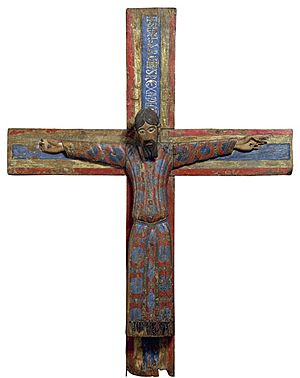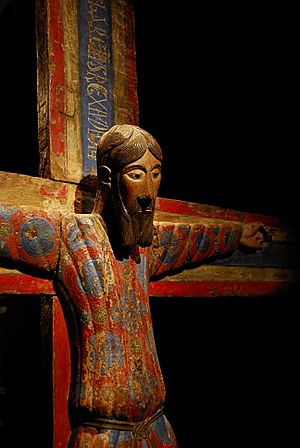Batlló Majesty facts for kids
Quick facts for kids Batlló Majesty |
|
|---|---|
 |
|
| Artist | Unknown |
| Year | mid-12th century |
| Type | sculpture |
| Medium | Carving in walnut (head and body), willow (right arm), elm (cross upright) and holm oak (cross arms) with polychrome tempera |
| Dimensions | 156 cm × 119 cm × 20.5 cm (61 in × 47 in × 8.1 in) |
| Location | Museu Nacional d'Art de Catalunya, Barcelona |
The Batlló Majesty (Catalan: Majestat Batlló) is a large wooden crucifix from the 12th century. This amazing artwork is now kept at the National Art Museum of Catalonia in Barcelona, Spain. It is one of the best examples in Catalonia of a statue of Christ on the Cross. It shows Christ looking strong and victorious over death.
Contents
What is the Batlló Majesty?
The Batlló Majesty is a 12th-century wooden carving. It is painted with many colors, which is called polychrome. It is one of the most beautiful and well-kept examples of these old Catalan sculptures.
In the past, carved wooden statues were very important in churches. They were used for religious worship in the Catholic Church. One special type of these statues in Catalonia was the "Christ in Majesty." These were large statues of Christ on the Cross that showed him as a winner over death. The Batlló Majesty is the most famous of these.
The statue's long robe, called a colobium, has a cool pattern. It looks like fancy fabrics from the Byzantine and Hispano-Moorish cultures. These fabrics were very popular in Europe back then. A famous example that inspired this style was the Holy Face of Lucca in Italy. People believed it had magical powers and went on special trips, called pilgrimages, to see it.
History of Wooden Crucifixes
Around the end of the 11th century, wood carving became very popular in Catalonia. Artists made four main types of statues to show the Crucifixion:
- Calvaries: These showed Jesus on the cross with Mary and Joseph.
- Deposition Tableaux: These included figures like Mary Magdalene, John the Apostle, Nicodemus, and Joseph of Arimathea.
- Majestats: These were large wooden crucifixes. They showed a triumphant Christ wearing a long, sleeveless robe called a colobium.
- Other Majestats: These showed Christ wearing only a loincloth, called a perizonium.
Wood carving workshops were still busy in the 12th century. Many were in the high valleys of the Pyrenees mountains in Catalonia. There are over thirty of these large crucifixes, known as majestats, still around today. The Batlló Majesty might have come from the Olot region near Girona.
We don't know who made most medieval art, including this one. But an old story says that Nicodemus made the sculpture soon after the real Crucifixion. This story was also told about other similar large crosses in Europe, like the Volto Santo in Lucca. People believed these Catalan crucifixes had miraculous powers.
Many majestats still exist in the Catalan provinces of Girona, Barcelona, and Lleida, and in the French province of Roussillon. Some experts think these large crosses used to hang in almost every Romanesque church in these areas. They were often placed near church entrances or altars. Sometimes, the backs of the majestats were painted with symbols like the Agnus Dei. This suggests they were also carried in religious parades.
The Batlló Majesty probably came from a church in the Garrotxa district. It was given to the museum in 1914 by Enric Batlló. The museum's inventory number for it is 015937-000.
How the Batlló Majesty Looks
The museum got this cross in 1914 from a collector named Enric Batlló. That's why it's named after him! His family also built the famous Casa Batlló in Barcelona. When the statue first arrived at the museum, it had a thick layer of varnish. This varnish hid its bright colors but also helped keep them safe. Now, the colors have been cleaned and restored.
Scientists have studied the statue to find out what colors were used. The red color came from a material called cinnabar. The blue color came from lapis lazuli. Both of these were very expensive back then! This suggests the sculpture came from an important art studio, maybe one near the Ripoll monastery.
What the Statue Means
The Batlló Majesty shows Christ looking calm and strong, even though he is suffering. He is wearing a colobium, which is a long, sleeveless tunic. His eyes are open, and his forehead is smooth. This makes him look peaceful and in control.
One special thing about the Batlló Majesty is how well its original colors are preserved. Christ's robe looks like rich silk from the Middle East. It has blue flower designs inside red circles with dots. A thin belt with a fancy knot pulls the tunic in at his hips. This makes the fabric above it puff out a little.
These robes, called colobiums, were worn by kings and priests. They send a message of strength to anyone looking at the statue. They can be seen as a picture of Christ from the Book of Revelation in the Bible. The idea of showing Jesus in this kind of robe goes back to a very old manuscript from 586 AD. It's thought that artists from Pisa brought this style to Catalonia in 1114. They came to help Ramon Berenguer III, Count of Barcelona in his fight for the Balearic Islands.
Above Christ's head, there is a Latin message. It says, "JHS NAZARENUS REX IUDEORUM." This means "Jesus of Nazareth King of the Jews." This phrase is found in the Bible in the books of Matthew (27:37), Mark (15:26), Luke (23:38), and John (19:19).
When Was It Made?
It's a bit tricky to figure out the exact date the Batlló Majesty was made. Some people think the writing on the cross and the painting could be from the 11th century. But other experts believe it's from the 12th century. They base this on how the painting looks, which is similar to other art from the Ripoll area around 1150. The robe also has a design similar to an Islamic pattern found in a monastery in Moissac. This shows how ideas and styles spread during the Romanesque period.
See also
 In Spanish: Majestad de Batlló para niños
In Spanish: Majestad de Batlló para niños
- List of statues of Jesus


